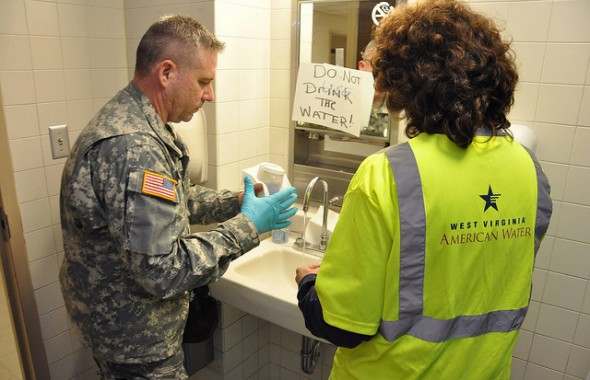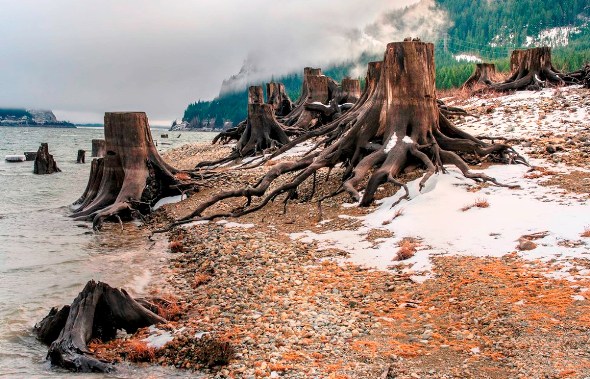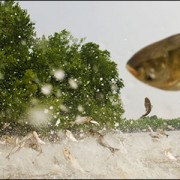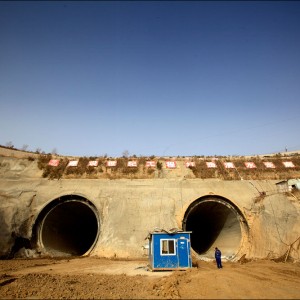One Year After West Virginia Chemical Spill, U.S. Drinking Water Protections Still Fall Short
Vulnerabilities, exposed by the spill and incidents in North Carolina and Toledo, remain.

A year ago today, Charleston, West Virginia, the state capital, slammed to a halt when more than 300,000 people found themselves without drinking water. A chemical spill upstream of the city’s only drinking water intake had poisoned the Elk River. Less than a month later in North Carolina, a storage basin failure at a Duke Energy power plant sent more than 35,000 metric tons of coal ash, a noxious waste product, flowing into the Dan River, a drinking water source. In August, toxic algae shut down drinking water for nearly half a million people in Toledo, Ohio. Then in December, petroleum from an unidentified source contaminated drinking water in Washington, D.C., neighborhoods.
From start to finish, 2014 shook confidence in one of the most fundamental ideas in America: that we can turn on the tap and get clean, safe water.
I wrote about both the West Virginia spill and the Toledo crisis for Circle of Blue. In the aftermath of the events, and in response to public outcry, elected officials at all levels of government were busy promising legislative and regulatory reform.
At the end of the year, some had delivered. West Virginia passed a law requiring an inventory of above-ground chemical storage tanks, inspections of those facilities, and the creation of source water protection plans for public water supplies. Between state and federal agencies, more than $US 166 million was unlocked to help Ohio and other states in the Lake Erie region respond to toxic algae threats. The Obama administration—though it stopped short of calling the material a hazardous waste—issued new rules for coal ash disposal and charged six individuals involved in the West Virginia chemical spill with federal environmental crimes under the Clean Water Act.
“People were encouraged by [the indictments] because it seems far and few between that we see any criminal prosecutions for environmental violations or crimes in West Virginia,” Angie Rosser, executive director of the West Virginia Rivers Coalition, told me this week. “It’s not common.”
Still, a lot was left on the table. Ohio, for example, has yet to pass legislation addressing the nutrient pollution behind Lake Erie’s algae problem. Measures that were introduced last year to restrict the application of manure fertilizers will likely be picked up again in the 2015 legislative session. In West Virginia, safe water advocates are concerned about funding and implementation of the law that passed last year. They also worry that the newly elected legislature—Republicans took control of both the state House and Senate for the first time in 80 years—could seek to weaken some of the law’s provisions.
To keep water issues at the forefront, the West Virginia Rivers Coalition, along with 27 other organizations that make up the recently formed West Virginia Safe Water Roundtable, is holding events today and throughout the month to engage the public. I asked Rosser if communities in West Virginia feel that their water is safer now than a year ago.
Her answer: “For the large part, no.”
Source water protection plans are not due to be complete until July 2016 and will likely cost millions of dollars. Residents affected by the Elk River chemical spill still have questions about the long-term health consequences. While the new storage tank registry is real progress and it answers questions about where and which chemicals are stored near drinking water sources, it also raises concerns that other harmful substances could already be leaching into the environment, Rosser said.
“All of these things that happened in the past year I really think have raised people’s consciousness about our relationship to water, how vulnerable our drinking water supplies are, and how it feels like it has gotten out of control,” Rosser told me. “It is something we have to rein in because without access to safe water, we have nothing.”
How are officials in your state responding to drinking water threats? Contact Codi Yeager
A news correspondent for Circle of Blue based out of Hawaii. She writes The Stream, Circle of Blue’s daily digest of international water news trends. Her interests include food security, ecology and the Great Lakes.
Contact Codi Kozacek









Leave a Reply
Want to join the discussion?Feel free to contribute!